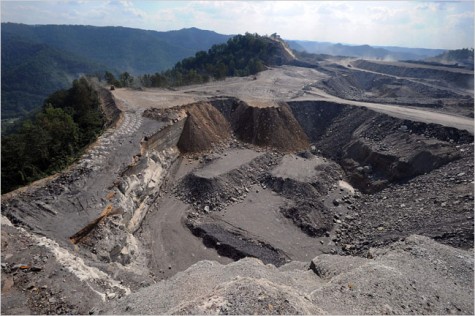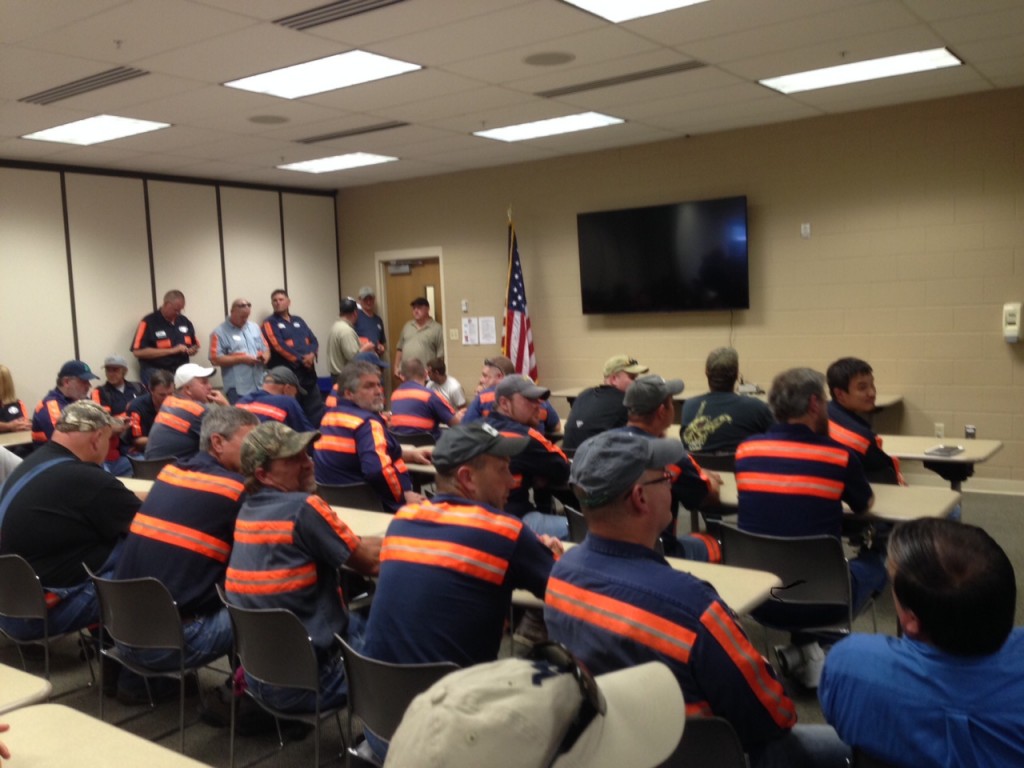
Photo by Commercial Photography Services of West Virginia, via U.S.Chemical Safety Board
It’s been nearly two months since the coal-cleaning chemical Crude MCHM poured into the Elk River, contaminating the drinking water supply for 300,000 West Virginians. And we’re now just a week out from the end of the regular, 60-day session of the West Virginia Legislature. Clearly, crunch time is approaching for lawmakers.
There have perhaps been some modest improvements in the way political leadership at the Capitol is handling things in the wake of the Freedom Industries disaster. A coal industry and WVDEP-backed weakening of the state’s water quality standard for aluminum appears to have been killed off. Some insiders say no one wanted to be out in front pushing a lessening of such standards right now, but it’s important to remember that the first instinct of some lawmakers — specifically the Senate Natural Resources Committee — was to go right along with what industry wanted, with few questions asked.
Clearly, there hasn’t been any wholesale movement — at least not yet — away from the typical way we do things, which is to talk a good game about protection water quality and public health, all the while going full-steam ahead with actions that do just the opposite.
But there’s also a very important opportunity to, at least where drinking water and the potential threats to it, especially from above-ground chemical storage tanks, are concerned take very real steps in a different direction — toward the public interest.
Late yesterday afternoon, the House Judiciary Committee’s leadership and staff unveiled the latest version of SB 373, the main legislative response to the water crisis. My colleague, David Gutman, describes the committee meeting in a Gazette story here, and the Daily Mail’s Dave Boucher has a story on the latest version of the bill here.
There’s much to like about the latest version of the bill. Like previous versions, it greatly expands on what was extremely limited language in West Virginia Code, simply giving the Department of Health and Human Resources authority to write rules concerning drinking water protections. Among the more significant moves by Chairman Tim Manchin is to strike from the bill most of those controversial exemptions that were originally proposed by the West Virginia Manufacturers Association, included in the governor’s bill, and carried over by the Senate and one previous House committee.
Largely, the bill would require state government to start doing what most experts say should have been done all along — actually take chemical inventory information, the location of various threats to public drinking water, and use that information to plan how to be sure those precious water supplies are protected.
Conspicuously absent from the bill right now, though, is any movement by the state to implement the previous recommendations by the U.S. Chemical Safety Board for a new chemical accident prevention program, both in Kanawha County and — perhaps — statewide.
Among the odd things that’s come up in the last few days is this development, as described by David Gutman:
Delegate Meshea Poore, D-Kanawha, asked Gov. Earl Ray Tomblin to call for the special session to focus solely on the water bill. She was joined by a bipartisan group of 26 other Delegates, including Minority Leader Tim Armstead, R-Kanawha.
“We will miss a golden opportunity to produce legislation that will instill a renewed sense of confidence in the administrative and legislative branches of West Virginia’s governance structure,” Poore said in the letter. “[A] resolution requires more time and concentration than the regular session affords.”
But House Speaker Tim Miley, D-Harrison, and Judiciary Chairman Tim Manchin, D-Marion, both said the special session was unnecessary.
“I regret that these members want to give up on passing a bill during the regular session when we still have plenty of time to perfect it,” Miley said in a news release.
On the one hand, there is an odd group of delegates supporting Delegate Poore’s request to delay this bill and deal with it during a special session. You have to wonder whether some of them have different motivations than simply providing time to write a better piece of legislation. Do some of the Republican simply hope to delay, and give industry more time to weaken the bill? Or is this at least partly about partisan politics, and trying to dredge up some squabbling between Democratic House leaders and their members?
Still, the reaction from Speaker Miley and Judiciary Chairman Tim Manchin was a bit over the top. You have to wonder why they simply didn’t respond by saying something like, “You know, a special session isn’t out of the question. But let’s see how far we can get, and then cross the bridge when we come to it.”
There’s no question that Chairman Manchin and his staff have put in a lot of time on their version of the bill. They held a “stakeholder” meeting last weekend, and actually bothered to include environmental groups — something Gov. Earl Ray Tomblin and his people didn’t bother to do when they wrote their version of the legislation. Still, it was not a public meeting of the Judiciary Committee that anyone could attend or listen to on the Internet. The result is an 80-page “committee substitute” bill that was drafted in private, rather than molded through a public process of debating and voting on amendments to the version that was already on the table.
Some will say that’s just the way things are done, and in fact the only way things can get done, given the part-time nature of our Legislature, and the meager staffing and resources that lawmakers have at their disposal. But at some point process matters, and the process we’ve used for decades in West Virginia hasn’t always served us very well.
Several years ago, Chairman Manchin heroically spent many, many months in open committee meetings trying to craft a strong bill to regulate the Marcellus Shale natural gas drilling boom in West Virginia, only to see that product severely weakened by Gov. Tomblin, whose office had previously refused to release its correspondence with industry lobbyists about how the Marcellus boom should be regulated.
That’s why one part of the new version of SB 373 that is most puzzling is 22-31-7, which is somewhat ironically titled, “Public Access to Information.” This is part of a section of the bill that requires the state to put together a list of potential contaminants located in the “zone of critical concern” near public drinking water intakes It starts out well enough:
… The public shall have access to all documents and information submitted to the agency … “
But, it goes on to say that if any such information:
“… Is requested to be kept confidential and good cause is found to grant the request, for reasons of security or other legitimate public interest concern, the protected information shall be redacted from public view and kept confidential, and it shall not be subject to public release in response to a Freedom of Information Act request … “
Not for nothing, but the state FOIA already contains at least 9 exemptions that were added after the September 11, 2001, terrorist attacks that are perfectly adequate to protect any secret squirrel information that needs to be kept confidential to protect our water supply from some evil-doers. But the bill as written creates a completely different test — “good cause … for reasons of security or other legitimate public interest concern” — than the difficult test for concealing any public records under our existing state FOIA, which mandates “the fullest possible disclosure.”
The way this version of SB 373 is written, Freedom Industries might very well have been able to conceal from public view any information about what it was storing at the Elk River site prior to last month’s chemical spill. It’s hard to believe that’s what Chairman Manchin and his staff intended.


 Subscribe to the Coal Tattoo
Subscribe to the Coal Tattoo
















